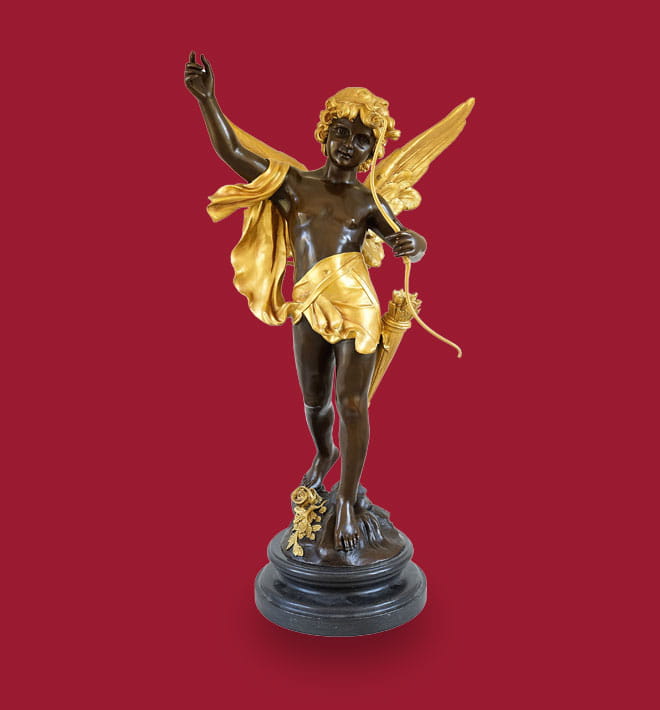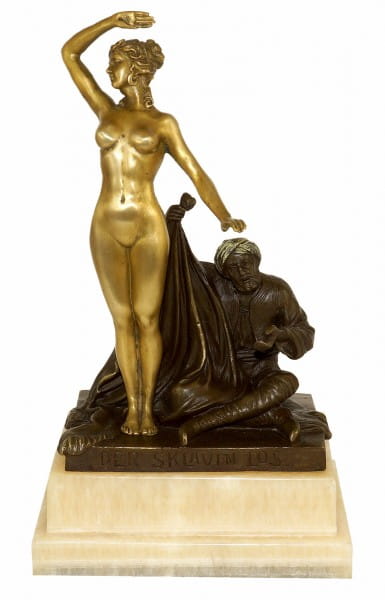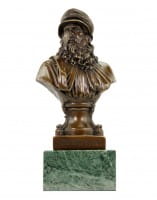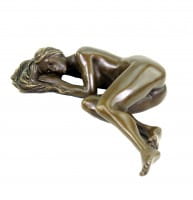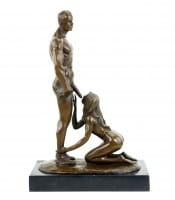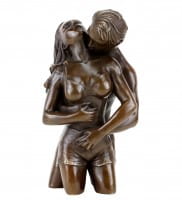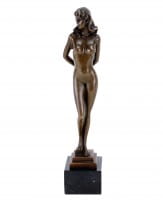€499.00 *
Prices incl. VAT, free shipping worldwide
Ready to ship today,
Delivery time appr. 3-6 workdays










The Enigmatic Allure of Freedom and Restraint: The Slave’s Fate (1910) – Signed - Eichler In... more
Product description
"Art Nouveau Statue - The Slave’s Fate (1910) - Signed by Theodor"
| Weight | 3,4 kg |
The Enigmatic Allure of Freedom and Restraint: The Slave’s Fate (1910) – Signed - Eichler
In "The Slave’s Fate (1910)", Theodor Eichler crystallizes the fragile moment between despair and defiance. A young woman stands half-turned, her gaze directed sideways, as if remembering a past she has left behind. Her left hand glides over a draped strip of fabric falling from her slender waist, while her right arm is stretched above her head, fingers spread in a silent invocation of unseen forces. The curves of her hips and the gentle swell of her breasts—rendered in burnished bronze—balance the tense drama of her pose, creating a powerful study in erotic nude art that transcends mere ornamentation.
Eichler's Artistic Path from Berlin to Vienna
Theodor Eichler, born in 1868 in Oberspaar near Meissen, devoted himself to his passion at the Berlin Academy of Fine Arts before honing his sensibility amidst the decorative experiments of the Vienna Secession. His early works—medallions, relief panels, and architectural ornaments—attracted the attention of patrons fascinated by the curved lines of Art Nouveau. In 1910, Eichler moved into a light-filled studio in Vienna's Leopoldstadt district, where he created "The Slave’s Fate (1910)" — the culmination of his classical training and modernist orientation.
Forged in the Creative Crucible of 1910
Originally modeled from ivory clay, this figure was created in the soft glow of gaslight. Every wrinkle, every strand of hair, was refined through countless reworkings. Eichler studied the living model for weeks, striving to convey not only anatomical perfection but also emotional authenticity. The clay original was then entrusted to a master foundry near the Danube, where it was immortalized using the lost-wax casting process. A final patination—a multi-layered coat of warm gold and soft chestnut brown—transformed the surface into living skin.
Anatomy Interwoven with Symbolism
Eichler's sculptural genius lies in his ability to weave mythical resonance into a nude statue. The slave's elegant musculature and noble bearing reflect ancient ideals of beauty, yet her clothing—part discarded garment, part tattered shroud—suggests a story of captivity and liberation. The raised arm becomes a gesture of reclamation; the downward sweep of her shoulders evokes restraint. Here, the female statue becomes a mirror of our own struggle between submission and self-liberation.
A Harmonious Combination of Form and Space
Elevated atop a gently veined yellow base, the figure's bronze patina captures the ambient light and casts shadows that change depending on the viewer's perspective. The smooth marble base contrasts with the sculpture's textured details—the fluted folds of fabric, the soft contours of ribs and hips—and conveys a visceral sense of skin and fabric. Whether in an elegant salon or a modernist loft, this sexy statue commands attention. Its Art Nouveau elegance combines classical grace with modern sensibility.
Eichler's Enduring Legacy in Bronze
Until his death in 1946, Theodor Eichler dedicated himself to exploring the interplay of human emotion and decorative form. His works—signed simply "Eichler"—graced exhibitions from Parisian to Munich salons and earned him recognition among connoisseurs of fine bronze. "The Slave’s Fate (1910)" is one of his most striking works—a lasting testament to his conviction that women statue must appeal to both the eye and the heart.
An Invitation to Contemplate Beauty and Liberation
"The Slave’s Fate (1910)" is an artistic meditation on the high price and radiant reward of freedom. This bronze tableau invites us to witness a unique moment of transformation, tracing the arc from captivity to self-assertion. It remains a milestone in erotic nude art, a tribute to the female form in all its power and vulnerability, and a moving reminder that beauty—and freedom—are forged in the fire of courage.
In "The Slave’s Fate (1910)", Theodor Eichler crystallizes the fragile moment between despair and defiance. A young woman stands half-turned, her gaze directed sideways, as if remembering a past she has left behind. Her left hand glides over a draped strip of fabric falling from her slender waist, while her right arm is stretched above her head, fingers spread in a silent invocation of unseen forces. The curves of her hips and the gentle swell of her breasts—rendered in burnished bronze—balance the tense drama of her pose, creating a powerful study in erotic nude art that transcends mere ornamentation.
Eichler's Artistic Path from Berlin to Vienna
Theodor Eichler, born in 1868 in Oberspaar near Meissen, devoted himself to his passion at the Berlin Academy of Fine Arts before honing his sensibility amidst the decorative experiments of the Vienna Secession. His early works—medallions, relief panels, and architectural ornaments—attracted the attention of patrons fascinated by the curved lines of Art Nouveau. In 1910, Eichler moved into a light-filled studio in Vienna's Leopoldstadt district, where he created "The Slave’s Fate (1910)" — the culmination of his classical training and modernist orientation.
Forged in the Creative Crucible of 1910
Originally modeled from ivory clay, this figure was created in the soft glow of gaslight. Every wrinkle, every strand of hair, was refined through countless reworkings. Eichler studied the living model for weeks, striving to convey not only anatomical perfection but also emotional authenticity. The clay original was then entrusted to a master foundry near the Danube, where it was immortalized using the lost-wax casting process. A final patination—a multi-layered coat of warm gold and soft chestnut brown—transformed the surface into living skin.
Anatomy Interwoven with Symbolism
Eichler's sculptural genius lies in his ability to weave mythical resonance into a nude statue. The slave's elegant musculature and noble bearing reflect ancient ideals of beauty, yet her clothing—part discarded garment, part tattered shroud—suggests a story of captivity and liberation. The raised arm becomes a gesture of reclamation; the downward sweep of her shoulders evokes restraint. Here, the female statue becomes a mirror of our own struggle between submission and self-liberation.
A Harmonious Combination of Form and Space
Elevated atop a gently veined yellow base, the figure's bronze patina captures the ambient light and casts shadows that change depending on the viewer's perspective. The smooth marble base contrasts with the sculpture's textured details—the fluted folds of fabric, the soft contours of ribs and hips—and conveys a visceral sense of skin and fabric. Whether in an elegant salon or a modernist loft, this sexy statue commands attention. Its Art Nouveau elegance combines classical grace with modern sensibility.
Eichler's Enduring Legacy in Bronze
Until his death in 1946, Theodor Eichler dedicated himself to exploring the interplay of human emotion and decorative form. His works—signed simply "Eichler"—graced exhibitions from Parisian to Munich salons and earned him recognition among connoisseurs of fine bronze. "The Slave’s Fate (1910)" is one of his most striking works—a lasting testament to his conviction that women statue must appeal to both the eye and the heart.
An Invitation to Contemplate Beauty and Liberation
"The Slave’s Fate (1910)" is an artistic meditation on the high price and radiant reward of freedom. This bronze tableau invites us to witness a unique moment of transformation, tracing the arc from captivity to self-assertion. It remains a milestone in erotic nude art, a tribute to the female form in all its power and vulnerability, and a moving reminder that beauty—and freedom—are forged in the fire of courage.
Height: 26 cm
Width: 15 cm
Depth: 11 cm
Weight: 3,4 kg
100% bronze
Related links to "Art Nouveau Statue - The Slave’s Fate (1910) - Signed by Theodor"
Read, write and discuss reviews... more
Customer evaluation for "Art Nouveau Statue - The Slave’s Fate (1910) - Signed by Theodor"
Write an evaluation
Evaluations will be activated after verification.
Our advantages
free shipping
Worldwide free shipping
14 days money back
You can cancel your order
within 14 days
secure payment services
Paypal, Master Card, Visa, American Express and more
NEW
NEW
NEW

